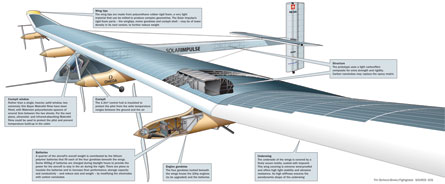It nearly failed to happen. When June's Paris air show opened with a torrential downpour accompanied by humidity and strong winds, the prospect of the sun-powered Solar Impulse experimental aircraft making its scheduled flying display appeared remote, given earlier warnings that everything depended on the conditions. And as the week wore on and Le Bourget's meteorological gloom persisted, the HB-SIA prototype seemed doomed to remain in its tent.
But the weekend brought a turn in fortunes for the Swiss outfit behind the aircraft, which had made its first international flight in May. A break in the weather meant that on Sunday, in the gaze of the visiting public, the Solar Impulse could finally be put aloft, and transformed from a damp squib to a show star.
NEXT MISSIONS
Following its visit to Paris, HB-SIA was flown back to its base at Payerne, Switzerland, landing there on 3 July. Now plans are being made for its next missions, Solar Impulse co-founder André Borschberg confirms. Two flights are pencilled in for next year, and Borschberg is hopeful that other continents can be visited - perhaps northern Africa and the Middle East.
"That is under study," he says. As it strives to build up the experience of its team, Solar Impulse is investigating how its type can be integrated with normal air traffic.
 |
|---|
© Tim Bicheno-Brown/Flightglobal |
Click here for a larger image of the Solar Impulse |
In parallel with the plans for HB-SIA, work on a new prototype, HB-SIB, is continuing. The configuration has been finalised, and manufacturing of certain parts is under way ahead of final design freeze. Construction of the wing, for example, began as scheduled on 1 July, Borschberg reveals.
"We're still working on improving the controllability, or the control authority, of the airplane," he adds. This task is complicated by the combination of large wings, low speed and light weight. While material of lower density will be deployed in the new prototype, it will still be heavier than its predecessor, reflective of a bigger wing span, chord and fuselage.
And engine power is set to almost double as the 10hp powerplants equipping HB-SIA make way for 15-20hp replacements to aid power balancing in the event of an engine failure on a long-distance transoceanic flight.
Where HB-SIA lacked for waterproofing, the second aircraft will be designed to cross and fly below clouds. And, through improved control authority, it should be able to better withstand turbulence. The prototype is to be built by 2013 and deployed transatlantically - perhaps even on a global circumnavigation - in 2014. "In the next 12 months we'll have a much more precise plan for that," says Borschberg, who will share piloting duties with Solar Impulse co-founder Bertrand Piccard.
Our environment specialist Kerry Reals profiles Solar Impulse and quizzes Bertrand Piccard at flightglobal.com/solarvideo
Source: Flight International























